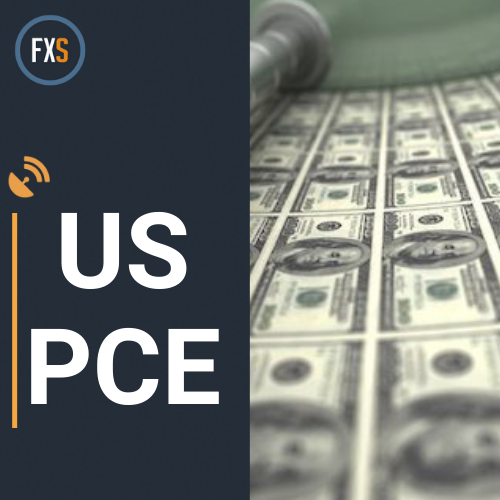- The core Personal Consumption Expenditures Price Index is seen rising 0.2% MoM and 2.7% YoY in July.
- Markets fully price in an interest-rate cut by the US Federal Reserve in September.
- A hotter-than-expected PCE inflation data could rescue the US Dollar ahead of next week’s Nonfarm Payrolls.
The United States (US) Bureau of Economic Analysis (BEA) will release the high-impact core Personal Consumption Expenditures (PCE) Price Index, the Federal Reserve’s (Fed) preferred inflation gauge, on Friday at 12:30 GMT.
The PCE inflation data could shape the next direction for the US Dollar (USD) heading into the Nonfarm Payrolls week.
PCE Index: What to expect from the Federal Reserve’s preferred inflation measure?
The core PCE Price Index is set to rise 0.2% over the month in July, at the same pace as seen in June. On year, core PCE is projected to grow by 2.7%, while the headline annual PCE inflation is seen ticking higher to 2.6% in the same period.
The core PCE Price Index, which excludes volatile food and energy prices, has a significant impact on the market’s pricing of the Fed’s interest rates outlook. The gauge is closely monitored by the central bank and market participants, as it’s not distorted by base effects and provides a clear view of underlying inflation by excluding volatile items.
Data published by the BLS earlier this month showed that the US Consumer Price Index (CPI) rose 2.9% on a yearly basis in July while the core CPI increased 3.2% in the same period, a tad slower than June’s rise of 3.3%.
Previewing the PCE inflation report, “Core PCE inflation likely stayed under control, with prices advancing at a soft 0.13% MoM pace in July. Given shelter price strength acted as a driver of core CPI inflation, the core PCE will not increase as much,” TD Securities analysts said.
“Headline PCE inflation likely printed 0.12% MoM. We also expect personal spending to provide a solid Q3 start, rising firmly at 0.5% MoM and 0.4% MoM in real terms,” they added.
How will the Personal Consumption Expenditures Price Index affect EUR/USD?
The US Dollar is languishing near yearly lows against its major rivals in the lead-up to the release of the Fed’s favorite preferred inflation measure. The Dollar downtrend has propelled the EUR/USD pair to the highest level in thirteen months near 1.1200.
Markets have fully priced in a rate cut by the Fed in September, with the odds leaning in favor of a 25 basis points (bps) rate reduction over a 50 bps move.
In case the monthly or the headline core PCE reading comes in hotter-than-expected in July, the US Dollar is likely to receive a much-needed boost, as the data would pour cold water on recent expectations of aggressive Fed rate cuts this year. In response, the EUR/USD pair could stage a correction from over one-year highs. On the other hand, a slower-than-expected increase in the core figures could trigger a fresh USD sell-off, triggering a fresh leg higher in EUR/USD.
The initial reaction to the PCE report, however, could be limited, as traders might resort to position readjustments on the final trading day of the week while gearing up for the next week’s critical US employment data.
FXStreet’s Analyst Dhwani Mehta offers a brief technical outlook for EUR/USD and explains:
“The EUR/USD uptrend remains intact so long as the 1.1107 support holds on a daily closing basis. That level is the 23.6% Fibonacci Retracement (Fibo) level of the August rally from 1.0775 to 1.1202, 13-month highs. The 14-day Relative Strength Index (RSI) stays firm well above 50, justifying the major’s bullish potential.”
“Acceptance above the 13-month high of 1.1202 is needed on a daily closing basis to challenge the 1.1250 psychological level. Alternatively, a sustained break below the abovementioned 23.6% Fibo support at 1.1107 could open up the downside toward the 38.2% Fibo level of the same advance, aligned at 1.1045.”
Fed FAQs
Monetary policy in the US is shaped by the Federal Reserve (Fed). The Fed has two mandates: to achieve price stability and foster full employment. Its primary tool to achieve these goals is by adjusting interest rates. When prices are rising too quickly and inflation is above the Fed’s 2% target, it raises interest rates, increasing borrowing costs throughout the economy. This results in a stronger US Dollar (USD) as it makes the US a more attractive place for international investors to park their money. When inflation falls below 2% or the Unemployment Rate is too high, the Fed may lower interest rates to encourage borrowing, which weighs on the Greenback.
The Federal Reserve (Fed) holds eight policy meetings a year, where the Federal Open Market Committee (FOMC) assesses economic conditions and makes monetary policy decisions. The FOMC is attended by twelve Fed officials – the seven members of the Board of Governors, the president of the Federal Reserve Bank of New York, and four of the remaining eleven regional Reserve Bank presidents, who serve one-year terms on a rotating basis.
In extreme situations, the Federal Reserve may resort to a policy named Quantitative Easing (QE). QE is the process by which the Fed substantially increases the flow of credit in a stuck financial system. It is a non-standard policy measure used during crises or when inflation is extremely low. It was the Fed’s weapon of choice during the Great Financial Crisis in 2008. It involves the Fed printing more Dollars and using them to buy high grade bonds from financial institutions. QE usually weakens the US Dollar.
Quantitative tightening (QT) is the reverse process of QE, whereby the Federal Reserve stops buying bonds from financial institutions and does not reinvest the principal from the bonds it holds maturing, to purchase new bonds. It is usually positive for the value of the US Dollar.
